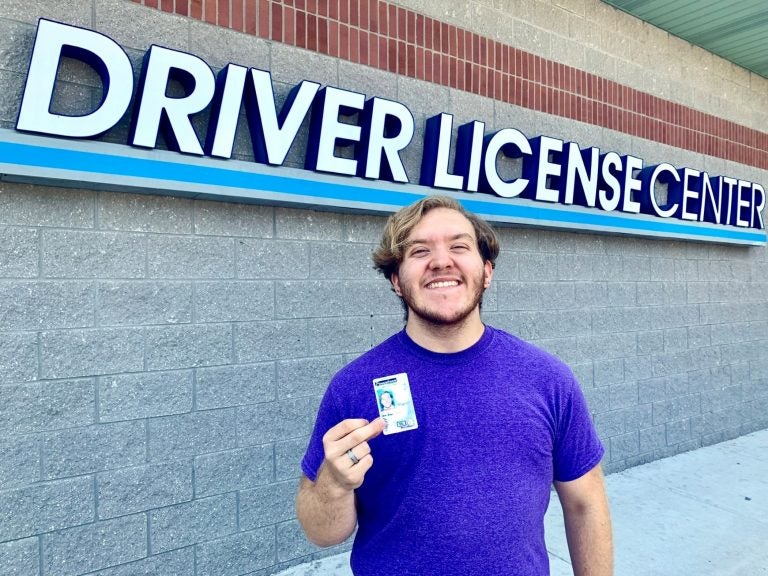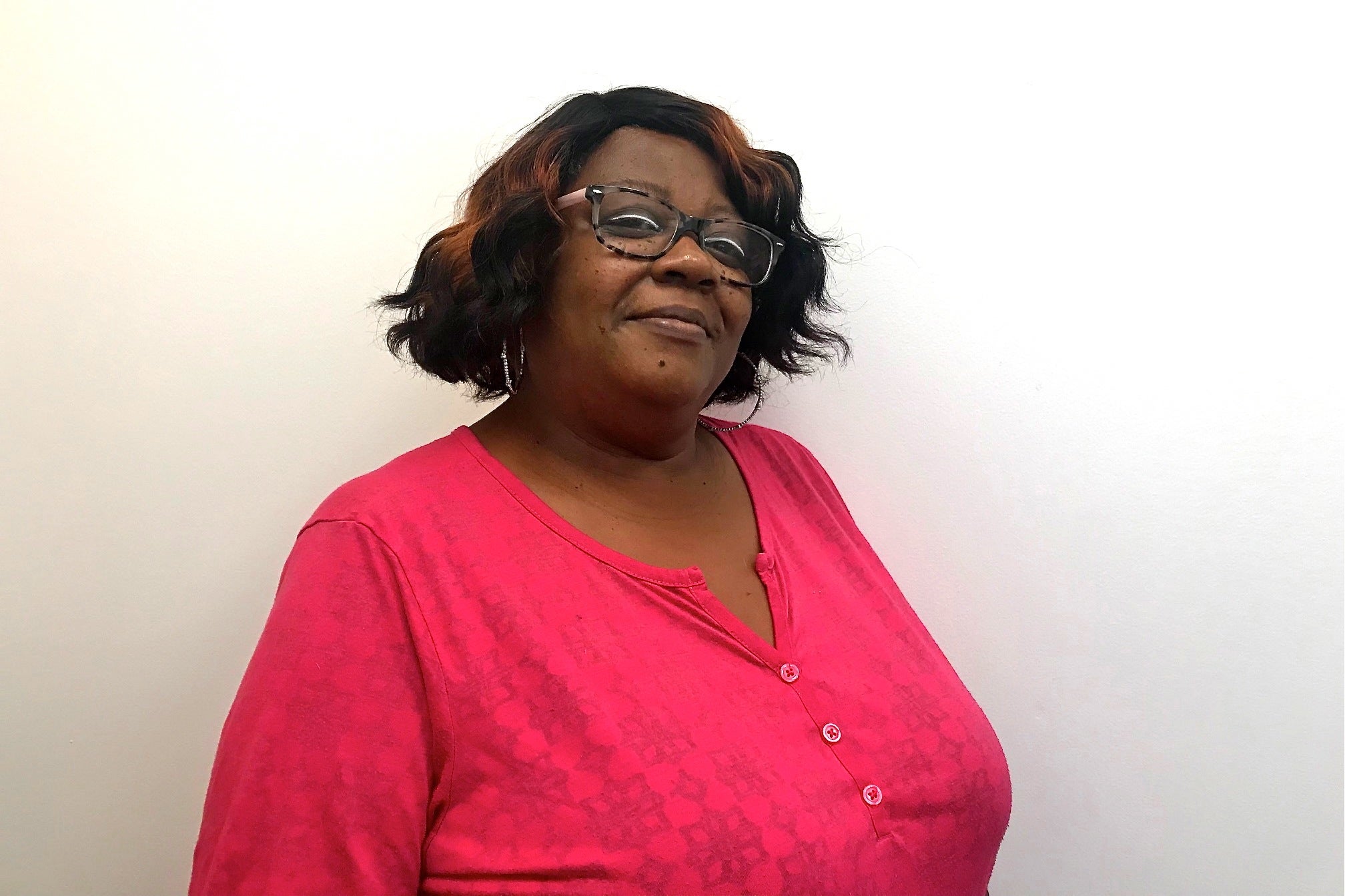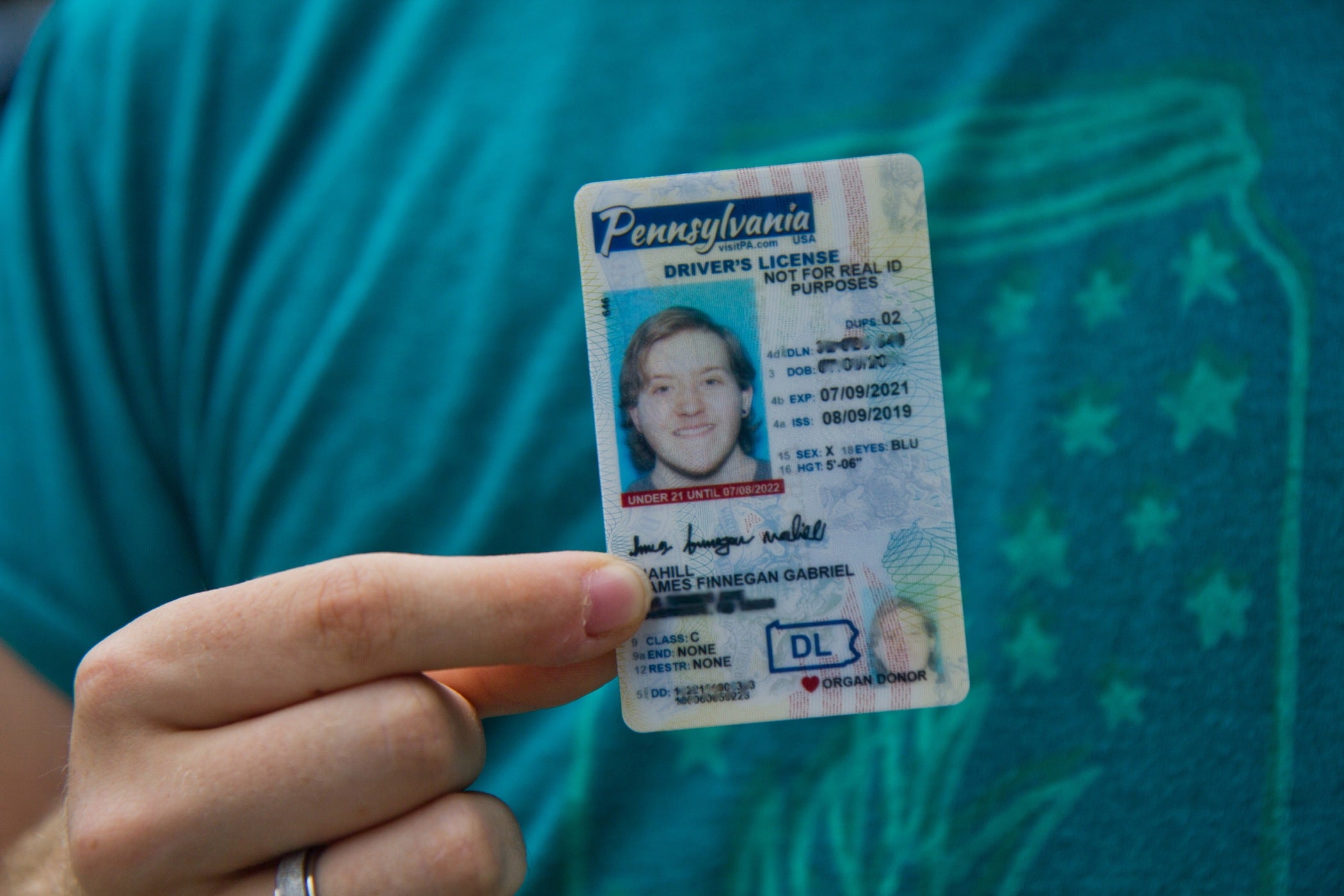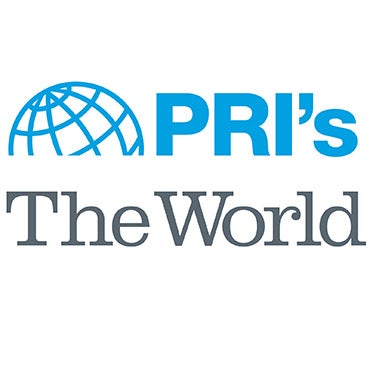The secret way some got a gender-neutral Pa. driver’s license
Trans and nonbinary Pennsylvanians got gender-neutral markers (“X” or “U” instead of “M” or F”) long before PennDOT said they could.
Listen 13:32
Finn Nahill got the first gender neutral marker on a driver's license issued by the Huntingdon Valley, Pennsylvania DMV. (Photo provided by Morgan Selkirk)
Listen to The Why wherever you get your podcasts:
Apple Podcasts | Google Podcasts | Stitcher | RadioPublic | TuneIn
By Alex Stern
Last month, PennDOT announced that it would roll out a plan to let Pennsylvanians have a gender-neutral marker — an “X” instead of an “M” or an “F” — on their driver’s licenses, starting in 2020. The agency says the new plan was implemented to offer better customer service to trans, nonbinary, and gender-nonconforming customers. But it is also a correction of an unofficial system that emerged years ago, when state employees and members of the LGBTQ community found a loophole that allowed them to obtain gender-neutral markers if they knew to try.
Eppchez Yes (who prefers the pronouns ey/em/eir in writing) was able to get a driver’s license with a “U” on it in January 2017. The “U” stands for undefined, and was primarily the letter trans and nonbinary people were able to obtain on their licenses in the past.
Yes decided to try to get the marker based entirely on a rumor. “A friend told me that they had seen, or someone else had seen, a driver’s license with a ‘U’ on it. I was like, OK, I’m going to see if it works,” ey said.
Yes looked around on PennDOT’s website and found form DL-32 (7-19), Request for Gender Change on Driver’s License/Identification Card. The form, which has to be signed by a therapist, doctor, or social worker, only has two boxes in the field where customers can check which gender they would like: Male and Female.
Yes and eir therapist drew in a third box on the form and labeled it “U.”
Yes did not think the doctored form would go down smoothly and mentally prepared to take PennDOT to court if ey were refused a gender-neutral marker.
“I was definitely really nervous and expecting it to be a problem, expecting someone to question me or stop me or say ‘This is not valid. You’re not valid,’” ey said. “Because that’s so much of how trans people are taught to expect the world will react to us: as you don’t have a right to exist the way you know you need to exist.”
Yes was called up to the desk of a PennDOT employee named Linda. (The Department of Transportation does not disclose its employees’ last names.) She didn’t bat an eye at the doctored form and had Yes’s new ID printed in minutes.
Victorious, Yes returned home and immediately wrote a long post in a Facebook group comprised of thousands of other LGBTQ+ Philadelphians. Ey explained exactly what ey had done to get the “U.” And ey told everybody: Go to Linda.
How Linda became a legend
The “U” gender option was not created with the intent of helping the trans community, or even with the purpose of appearing on driver’s licenses.
It was a part of PennDOT’s recordkeeping system. If somebody with an out-of-state license commits a driving offense like a DUI, a Pennsylvania court can still suspend that person’s license. The record is sent over to PennDOT, so that PennDOT can share it with other states. But a court report might not include gender. When that happened, rather than making an assumption, an employee could mark the gender undefined, or “U.”
“It seems like staff realized that it was possible because … there’s a third option in the little dropdown option on their screen,” said Alexis Campbell, press secretary at PennDOT.
At some point (PennDOT was unable to identify when), a trans or nonbinary person asked for something other than an “M” or an “F” on a driver’s license. The agency employee who was handling the request noticed that was possible, and granted it.
From there, word spread. After Yes posted eir success, other people followed suit. Linda became something of a folk legend, an ally people would specifically travel to and ask for.

Linda credits these requests to her exceptional customer service. “I may go a little bit beyond because personally it’s something that I do. Everybody has their own way of making customers feel comfortable. Me, I use a lot of humor,” she said.
One customer remembered Linda saying there should be a “N” option for gender, with the “N” standing for “None of your dang business.”
She also makes it her personal policy to treat everybody equally. “All I want is for people to be comfortable. Because I’m comfortable with everybody, so I want everybody to be comfortable with me … People are people, and they need to be treated like people.”
That treatment was certainly valued by people looking for a gender-neutral marker they weren’t sure they were allowed to have — a friendly face makes a big difference when you’re nervous. But it was also unclear to some who sought Linda out whether she was breaking the rules by helping them.
The Mazzoni Center in Philadelphia, which has a team dedicated to helping trans and nonbinary transition, including things like making sure people’s documentation properly reflects their gender, also relied on word-of-mouth.
“We were having folks go to a specific PennDOT at a specific time,” said Mazzoni Center social worker Dexter Rose. “Like, this is the way that we know this has been easiest for folks. Just trying to follow that formula.”
Linda was not the only PennDOT employee to help people get the “U” designation, and she and the other workers were not breaking the law or doing something wrong. PennDOT emphasizes that the documents they issued were official and valid, even if they were providing them via a process that wasn’t strictly following official policy.
But the unofficial system wasn’t accessible to people who didn’t have a friend or a social worker to tell them about it. It was daunting for people who didn’t feel comfortable advocating for themselves and asking a government agency for an off-menu item.
Rose said this request, along with the doctored form, could make it feel shameful. “If you have to do something outside of the box without having that official paperwork, it can feel like, oh, I’m a secret, or like this is something that I’m not supposed to do.”
It’s also unclear whether presenting the form was entirely necessary. People did present it, and Rose estimated that the Mazzoni Center’s social workers signed it about a dozen times. But because the process was initiated by employees, there was no directive from PennDOT about what was required to get the marker. PennDOT did not offer its employees any kind of instruction on how to handle cases like this until May of this year.
It also left open the possibility that some people requesting gender-neutral markers would be turned away. The Mazzoni Center wasn’t aware of that happening to anybody it helped, but it did happen to Finn Nahill.
Third time’s the charm?
Finn Nahill is 18 years old (and prefers the pronouns they/them/their). They followed somebody on Instagram who’d gotten a “U,” and they wanted to get one before going off to college in the fall.
“If I’m going to college and I’m moving to a new state and I get to decide who I am, surrounded by people who do not know me, I want this piece of plastic to have me labeled the way I want to be labeled,” Nahill said.
They say they went to the Huntingdon Valley driver’s license office with their mom in late 2018, only to be told a gender-neutral marker wasn’t an option.
In late July, they tried again. Per recommendations on Facebook, they made the pilgrimage to the West Philadelphia license off from their home in Abington, Montgomery County. “I … heard very good things about Linda. Unfortunately I don’t think I met Linda,” said Nahill.
Two employees had a hushed conversation behind a desk. Nahill was told that, while a gender-neutral marker used to be an option, it wasn’t anymore.
Nahill went home, and they also immediately posted in the Facebook group. That folk wisdom spread, too.

A few days later, PennDOT made its announcement about gender-neutral “X” designations being available come 2020. Nahill’s mom called state Rep. Ben Sanchez to see what could be done to help her child. Sanchez’s office connected with PennDOT for the Nahill family, and ultimately his chief of staff, Morgan Selkirk, accompanied Nahill to the driver’s license office. It was Nahill’s third attempt at a gender-neutral designation, and the first to go smoothly. The staff there said Nahill was the first person to receive an “X” designation from the Huntingdon Valley PennDOT center.
“The predominant feeling when I left was just kind of relief,” Nahill said. “I was like, great, now I’m done. I have it. I don’t have to deal with fighting PennDOT again. I don’t have to deal with trying to negotiate this weird government thing that nobody knows how to do.”
The future of the “X”
According to PennDOT, nobody should have to jump through hoops like Nahill did to get a license.
“We want to create a place where all of our customers feel welcome, and we want to create a process that feels that way too,” said press secretary Alexis Campbell. “And so if at any point a customer who wanted to get an ‘X’ couldn’t get it, I’m sorry.”
PennDOT’s rollout of the “X” in 2020 is intended to fix the unofficial process. It will eventually involve training for all employees, and information on its website for how to go about getting an “X” license.
The official system isn’t being put into place immediately because the agency is still hammering out exactly what it will look like. One of the things it’s reexamining: form DL-32. The form may be reissued with a third “X” box, but PennDOT also is considering whether applicants should need a doctor, therapist, or social worker to sign the form. Advocates like Dexter Rose at the Mazzoni Center prefer self-identification, and hope that will be the case in the future.
But it is still possible to get an “X” on your driver’s license now, before the official new system. PennDOT requests that people who want gender-neutral markers still bring in form DL-32 with the third box drawn in, but the ultimate goal is to not turn anybody away in this interim period.
“The form is great. It’s helpful. If they don’t have it, we can work through it,” said Campbell.
In May, employees were told to call the central PennDOT office if anybody requested an “X.” Somebody there would then walk them through the process to ensure it goes smoothly. That continues to be PennDOT’s interim plan.
One question that remains is how Pennsylvania’s new gender-neutral designation will interact with federal systems. What happens if you show up to get a passport with a driver’s license that says one gender and a birth certificate that says another? There is no gender-neutral marker available for passports.
The Mazzoni Center’s Rose envisions a future where gender doesn’t appear as a marker on any identification in the first place. That way, the burden of finding the proper back door into multiple government agencies doesn’t fall to trans and nonbinary people.
And, Rose said, “For a lot of folks, gender is fluid. It might change over time. Removing [the marker] altogether would be my ideal goal.”
WHYY is your source for fact-based, in-depth journalism and information. As a nonprofit organization, we rely on financial support from readers like you. Please give today.







